Frieze New York is underway at The Shed as of this writing, and museums all over the city are unveiling their spring and summer programming. But some New York City residents are able to enjoy art simply by going to their building's lobby or amenity space.
Specially commissioned art is a hallmark of some of New York City's most luxurious condominiums, but this privilege is not just for buyers. Zoe Elghanayan, Senior Vice President of real estate developer TF Cornerstone (TFC), has made art a key feature of model units in her firm's rentals as well as their common spaces. We spoke to Ms. Elghanayan about how art can elevate a building and choosing the right artists for a project.
Specially commissioned art is a hallmark of some of New York City's most luxurious condominiums, but this privilege is not just for buyers. Zoe Elghanayan, Senior Vice President of real estate developer TF Cornerstone (TFC), has made art a key feature of model units in her firm's rentals as well as their common spaces. We spoke to Ms. Elghanayan about how art can elevate a building and choosing the right artists for a project.
In this article:
Michelle Colman: What is your experience with art?
Zoe Elghanayan: I come from a family of artists, collectors, and art enthusiasts, so there was always an appreciation for art while I was growing up. I studied art theory at The New School and worked at a variety of different art galleries as well as Sotheby’s auction house, before joining TFC. I was pleasantly surprised to see how dynamic my role could be while focused on residential leasing, marketing, collections and compliance.
Zoe Elghanayan: I come from a family of artists, collectors, and art enthusiasts, so there was always an appreciation for art while I was growing up. I studied art theory at The New School and worked at a variety of different art galleries as well as Sotheby’s auction house, before joining TFC. I was pleasantly surprised to see how dynamic my role could be while focused on residential leasing, marketing, collections and compliance.
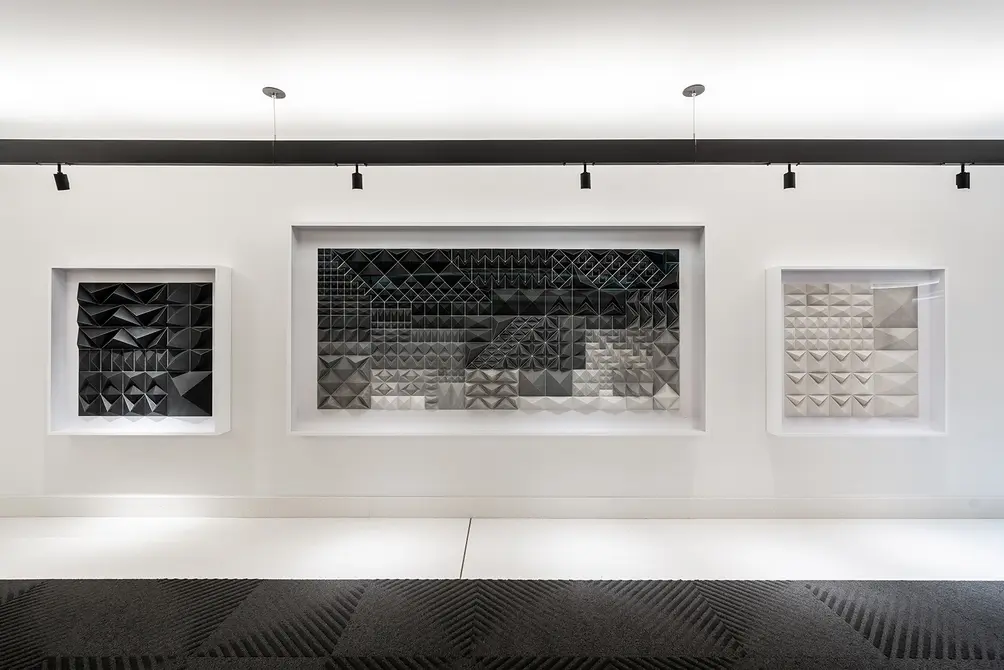 Not a scene from a museum, but from Far West Side rental The Max (As Long as You’re Here, 2018 v.1, v.2 & v.3, Matthew Shlian - TF Cornerstone)
Not a scene from a museum, but from Far West Side rental The Max (As Long as You’re Here, 2018 v.1, v.2 & v.3, Matthew Shlian - TF Cornerstone)
Michelle: How have you been able to apply your art background to your real estate career?
Zoe Elghanayan: I try to integrate design, art and functionality into all the projects I work on. Many of our renovation and model apartment staging projects are handled in-house, and for larger new construction projects, I work closely with the architects on the building interiors. Most often, an art program is not part of the architect’s scope, so I take the lead from there. I’ve always found it difficult to finalize the art program before a building is up; it always feels different once it’s physically built.
Zoe Elghanayan: I try to integrate design, art and functionality into all the projects I work on. Many of our renovation and model apartment staging projects are handled in-house, and for larger new construction projects, I work closely with the architects on the building interiors. Most often, an art program is not part of the architect’s scope, so I take the lead from there. I’ve always found it difficult to finalize the art program before a building is up; it always feels different once it’s physically built.
As the building goes up, new connections are made, and a building’s identity begins to unfold. We also create a big, creative brand for the marketing component for each building during the initial lease-up, but oftentimes that creative branding is lost after a lease-up. I see my contribution to a building’s creative branding and art program as a great storytelling opportunity and a way to keep the identity of a building alive long after the initial lease-up.
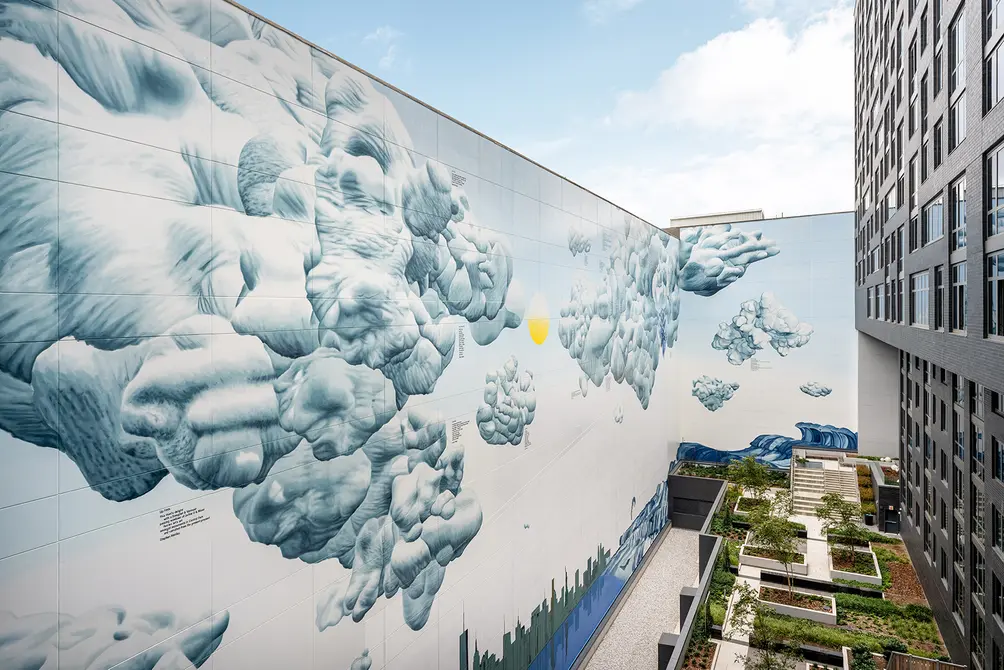 The Max mural
The Max mural
Michelle: What does art add to your residences?
Zoe Elghanayan: Art elevates the quality of life for residents and gives each building a distinct identity. It goes beyond simply ticking amenity boxes in the competitive luxury rental market. Each building has its own story, and I love having a hand in communicating that story and identity to a building’s residents.
For example, at The Max, we worked with Karlssonwilker Inc. to develop a large mural that combined image and poetry, working with the New York Poetry Society to commission poems inspired by different TFC neighborhoods. Art gives the building soul—it transforms it into something more personal and meaningful. It’s challenging to select pieces that appeal to a broad audience, but it’s rewarding when it works.
Zoe Elghanayan: Art elevates the quality of life for residents and gives each building a distinct identity. It goes beyond simply ticking amenity boxes in the competitive luxury rental market. Each building has its own story, and I love having a hand in communicating that story and identity to a building’s residents.
For example, at The Max, we worked with Karlssonwilker Inc. to develop a large mural that combined image and poetry, working with the New York Poetry Society to commission poems inspired by different TFC neighborhoods. Art gives the building soul—it transforms it into something more personal and meaningful. It’s challenging to select pieces that appeal to a broad audience, but it’s rewarding when it works.
The mural project was a multi-year collaboration and challenge, given that the mural itself was intended for the façade of the adjacent Department of Sanitation (DSNY) building. Given the location, we required approval from not just the DSNY, but also the Public Design Commission. The effort that went into this project was a worthwhile one, given the significant impact it would have on the views from many apartments at The Max. We didn’t want residents to feel like they were facing a concrete wall.
Karlssonwilker proposed a number of different designs, some with interactive elements that would change over time, but ultimately, we settled on a serene depiction of the sky, water, and NYC skyline—something timeless and with the added bonus of poetry. Commissioned works from ten local poets are nestled within the skyline’s cloudscape along with six morsels of public domain poetry (all with a NYC theme).
Karlssonwilker proposed a number of different designs, some with interactive elements that would change over time, but ultimately, we settled on a serene depiction of the sky, water, and NYC skyline—something timeless and with the added bonus of poetry. Commissioned works from ten local poets are nestled within the skyline’s cloudscape along with six morsels of public domain poetry (all with a NYC theme).
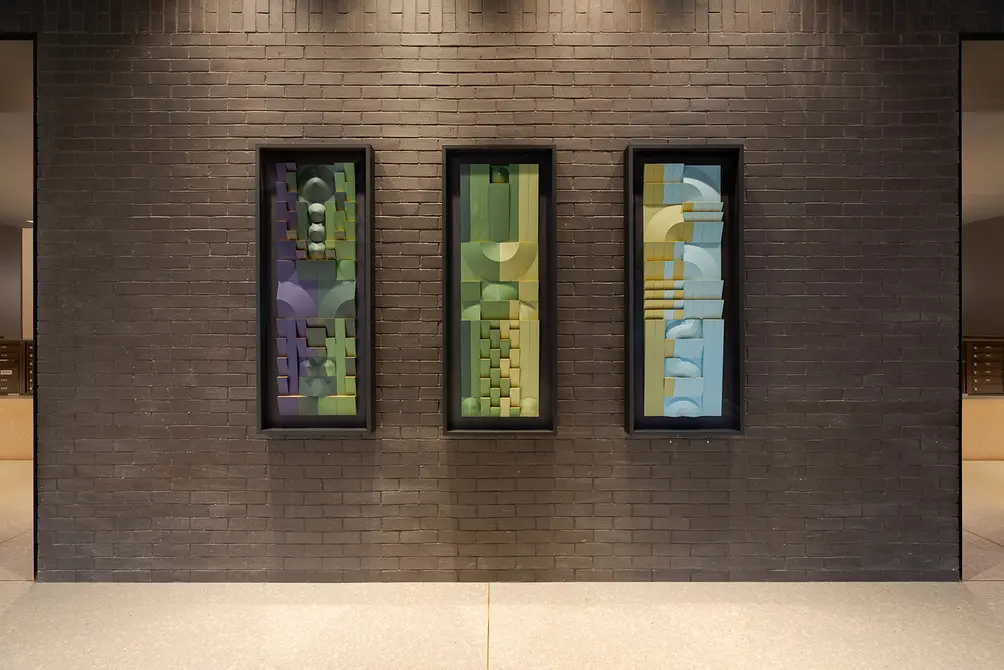 Malt Drive lobby with art by Matthew Shlain
Malt Drive lobby with art by Matthew Shlain
Michelle: How do you choose the artists for your projects?
Zoe Elghanayan: Once I find an artist I like working with, I often continue to collaborate with them on future projects. For example, at The Max, I worked with Matthew Shlian, a paper artist I came across online. I asked him to incorporate my brother Max’s handwritten notes and doodles into the artwork, which became deeply personal for me. The series is titled ‘As Long As You’re Here”. Nearly eight years later, I approached Shlian with more custom work for 2-20 and 2-21 Malt Drive, our newest waterfront developments in Hunter’s Point South, Queens. This time, the patterns Shlian was working with were all taken from the Art Deco and Frank Lloyd Wright-inspired patterns used in the creative branding for the Malt Drive lease-up.
Zoe Elghanayan: Once I find an artist I like working with, I often continue to collaborate with them on future projects. For example, at The Max, I worked with Matthew Shlian, a paper artist I came across online. I asked him to incorporate my brother Max’s handwritten notes and doodles into the artwork, which became deeply personal for me. The series is titled ‘As Long As You’re Here”. Nearly eight years later, I approached Shlian with more custom work for 2-20 and 2-21 Malt Drive, our newest waterfront developments in Hunter’s Point South, Queens. This time, the patterns Shlian was working with were all taken from the Art Deco and Frank Lloyd Wright-inspired patterns used in the creative branding for the Malt Drive lease-up.
 Reception desk at The Max
Reception desk at The Max
For The Max's rebranding project, we worked with Proponent Agency, who were responsible for the building’s monogram and created a linearized version of it that evolved into a fractal design based on the Pythagorean tree equation, located behind the front desk. The monogram is repeated throughout the building in custom works by Steven Bennett, Minako Iwamura, and Bower Studios. Proponent Agency is also responsible for creating the branding for our 595 Dean Street and Malt Drive developments.
Michelle: Can you share more about integrating art into building designs?
Zoe Elghanayan: Absolutely. I am particularly keen on design details that also serve a functional purpose. This has led to repeated custom jobs by Mark Jupiter and Bower Studios. Sometimes furniture becomes the art when budgets or building programs don’t allow for traditional art installations. For instance, at 595 Dean Street in Prospect Heights, we worked with Mark Jupiter to create a custom work table made from salvaged materials like historic banisters taken from a commercial renovation job that had been going on during the DD phase of 595 Dean Street.
Zoe Elghanayan: Absolutely. I am particularly keen on design details that also serve a functional purpose. This has led to repeated custom jobs by Mark Jupiter and Bower Studios. Sometimes furniture becomes the art when budgets or building programs don’t allow for traditional art installations. For instance, at 595 Dean Street in Prospect Heights, we worked with Mark Jupiter to create a custom work table made from salvaged materials like historic banisters taken from a commercial renovation job that had been going on during the DD phase of 595 Dean Street.
 Chen Chen & Kai Williams caviar sconces
Chen Chen & Kai Williams caviar sconces

Another great example of function meeting art are the sixteen Chen Chen & Kai Williams caviar sconces located throughout the lobby of 2-21 Malt Drive. I had first seen one of these caviar sconces at a design house exhibition, years before starting work on Malt Drive. Needless to say, the viewing experience was a memorable one, and when I mentioned the designs to the architect working on the interiors of Malt Drive, she was very familiar and worked them into the lobby design seamlessly.
The same Frank Lloyd Wright and Art Deco-inspired patterns that we commissioned Matthew Shlian to work with in the lobby of 2-20 Malt Drive were used for the custom Bower Studios mirrors in the lobby of 2-21 Malt Drive.
The same Frank Lloyd Wright and Art Deco-inspired patterns that we commissioned Matthew Shlian to work with in the lobby of 2-20 Malt Drive were used for the custom Bower Studios mirrors in the lobby of 2-21 Malt Drive.
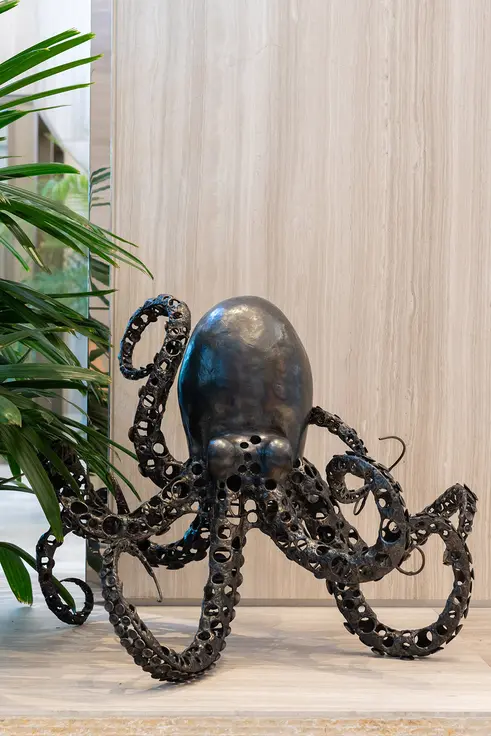 Malt Drive lobby art by Christine Galvez
Malt Drive lobby art by Christine Galvez
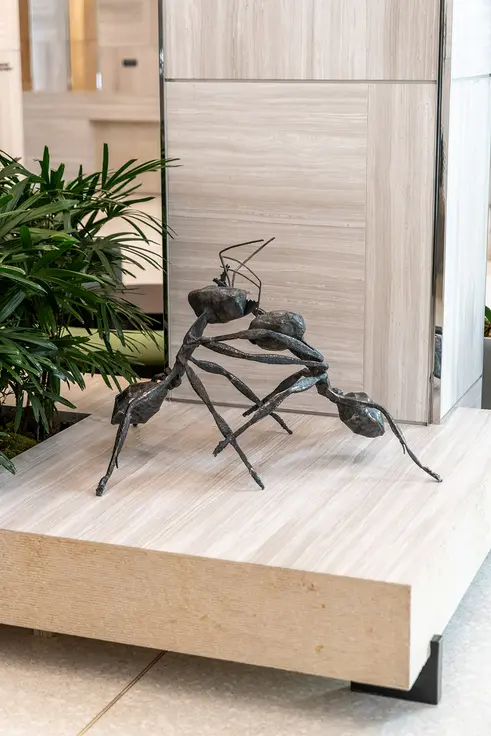 Malt Drive lobby art by Judith Weller
Malt Drive lobby art by Judith Weller
Michelle: How much does the neighborhood influence your choice of art for a building?
Zoe Elghanayan: Another component of the creative branding for Malt Drive was the use of particular animals native to the development site. This native animal theme, as well as our desire to support the local artist community, led to two sculptures that TFC purchased through nonprofit art gallery CultureLab LIC last summer, from their exhibition focused on female welders. A pair of welded steel dancing ants by Judith Weller and an octopus by Christine Galvez. Working with Christine Galvez was such an inspiration that we commissioned two more pieces for the lobby of 2-21 Malt Drive; a heron and an oyster, which were also inspired by the animals used in the branding for Malt Drive.
Zoe Elghanayan: Another component of the creative branding for Malt Drive was the use of particular animals native to the development site. This native animal theme, as well as our desire to support the local artist community, led to two sculptures that TFC purchased through nonprofit art gallery CultureLab LIC last summer, from their exhibition focused on female welders. A pair of welded steel dancing ants by Judith Weller and an octopus by Christine Galvez. Working with Christine Galvez was such an inspiration that we commissioned two more pieces for the lobby of 2-21 Malt Drive; a heron and an oyster, which were also inspired by the animals used in the branding for Malt Drive.
Integrating site and building history into our projects is also very important to TF Cornerstone. Artifacts were salvaged during the construction of Malt Drive and placed throughout the site as decorative elements. These pieces include a mooring post, roof vents, star anchor plates and three propellers. At The Max, the neon sign taken from the original garage site was swapped out for LED lights and placed as a decorative feature within the main amenity floor.
It’s always a layered, collaborative process involving many people and different TFC departments—from architects to branding agencies—and every project has a story behind it, even if most residents aren’t fully aware of all the details.
It’s always a layered, collaborative process involving many people and different TFC departments—from architects to branding agencies—and every project has a story behind it, even if most residents aren’t fully aware of all the details.
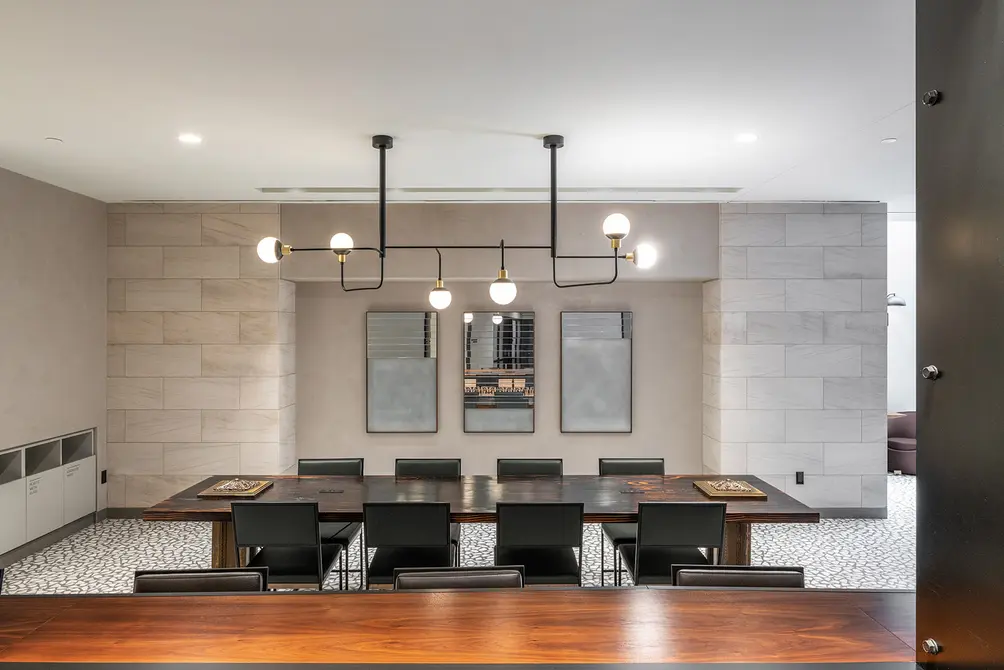 Coworking lounge at 595 Dean Street
Coworking lounge at 595 Dean Street
Michelle: How do you balance functionality and artistry in your projects?
Zoe Elghanayan: It’s very challenging because we work within strict budgets, and furniture and art have to withstand heavy use. Even the most beautiful pieces can get damaged over time. That’s why we often work with craftspeople like Mark Jupiter, who not only create beautiful work but can also repair it. It’s worth the investment when you consider the long-term value.
Zoe Elghanayan: It’s very challenging because we work within strict budgets, and furniture and art have to withstand heavy use. Even the most beautiful pieces can get damaged over time. That’s why we often work with craftspeople like Mark Jupiter, who not only create beautiful work but can also repair it. It’s worth the investment when you consider the long-term value.
At 595 Dean Street, we leaned heavily on custom mirrors by Bower Studios as well as furniture pieces by both Bower Studios and Mark Jupiter Design. These decorative aspects were the centerpiece of the art program at the building. The art program revolves around the experience of living in the building and traversing between the two tower development. A special collaboration between Bower Studios and Wüd Furniture can be found in the form of a triptych mirror representing the building’s elevations. Every decision is deliberate, balancing beauty, function, and durability.
Michelle: What else are you involved with besides art in your projects?
Zoe Elghanayan: I also work on the apartment renovations throughout our residential portfolio. It’s fascinating because many of the buildings we manage today were originally conversions done by the founders in the 1980s. Renovating these apartments is like uncovering layers of history—you never know what you’ll find behind the walls! It’s a way of maintaining and refreshing the legacy while bringing a modern touch to the spaces. The same goes for renovations to residential common areas. After a certain number of years, many design and amenity trends will go out of style. It’s important to stay nimble and be able to adapt to the ever-changing trends of luxury residential housing.
Zoe Elghanayan: I also work on the apartment renovations throughout our residential portfolio. It’s fascinating because many of the buildings we manage today were originally conversions done by the founders in the 1980s. Renovating these apartments is like uncovering layers of history—you never know what you’ll find behind the walls! It’s a way of maintaining and refreshing the legacy while bringing a modern touch to the spaces. The same goes for renovations to residential common areas. After a certain number of years, many design and amenity trends will go out of style. It’s important to stay nimble and be able to adapt to the ever-changing trends of luxury residential housing.

Contributing Writer
Michelle Sinclair Colman
Michelle writes children's books and also writes articles about architecture, design and real estate. Those two passions came together in Michelle's first children's book, "Urban Babies Wear Black." Michelle has a Master's degree in Sociology from the University of Minnesota and a Master's degree in the Cities Program from the London School of Economics.

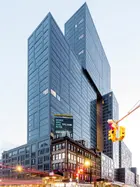
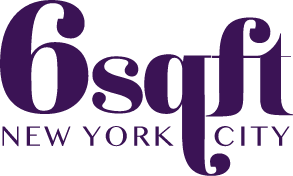 6sqft delivers the latest on real estate, architecture, and design, straight from New York City.
6sqft delivers the latest on real estate, architecture, and design, straight from New York City.
